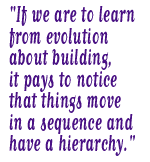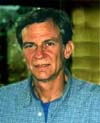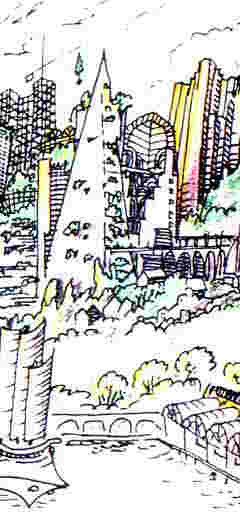BUILDING ECOCITIES:
An Interview with Richard Register
January, 2000
Part one of a three-part series - Page 1 of 3
Designer, builder, visionary, and pragmatist, Richard Register is the veteran of thirty years of frontline action in the battle against urban sprawl—and for the rebuilding of our cities so they harmonize with nature. Based in Berkeley, California, but a well-traveled citizen of the world, Register has campaigned locally and globally to turn his vision of the compact, pedestrian-oriented ecocity into a reality.
His impressive list of achievements includes writing two books (he's at work on a third) and numerous articles, founding two active organizations, Urban Ecology and Ecocity Builders, restoring urban creeks and streets, and being one of the prime movers behind three International Ecocity Conferences (with a fourth scheduled for this April.)
In this three part interview, Register shares his ecocity vision, reflects on his successes and failures, and looks to the future. In Part I (this issue), he discusses the role of cities in the biosphere and evolution, and basic principles of ecocity design. Part II, to be published in our February 1, 2000 bonus issue, he focuses on the past and upcoming International Ecocity Conferences. Part III, in our regular March/April issue, discusses specific tools for urban revitalization, such as transfer development rights, and Register's work in his home town of Berkeley.
I met with Richard Register shortly after he returned from a conference on habitat, the internet and evolution held at the futuristic city of Arcosanti in northern Arizona.
ECOTECTURE: Tell me about the conference on the electronic future of design at Arcosanti.
RR: There was a fellow there name Marcos Novak. He was talking about trans architecture, liquid architecture, and architecture that is electronically animated. For example, he was talking about walls that had little pistons that you were supposed to touch, and you feel whatever is transmitted to the piston wall from some remote location. If someone else is pressing on the opposite of the piston wall in New York, and you were feeling the other side in, say, Los Angeles, you would have a tactile contact. It is fun, it seemed like an art piece and all kinds of communication was possible. You can imagine all sorts of erotic things evolving. (laughs) Then there were examples of projected imagery using holographs and tying them in with computers and these would move across the countryside and people could get communications. This all in the conference at Arcosanti on habitat, the internet, and evolution.

The way a lot of the people representing the cyberspace world were thinking was that we are now at another (rapidly growing) level of evolution which is the cyber evolution in the conscious realm. Part of what is going on at Arcosanti is the city, the "arcology" as Paolo Soleri calls it —architecture and ecology working together— is a step in the evolution of consciousness on the planet, and in the universe for that matter. This thinking is based on the ideas of Teilard de Chardin who Paolo admirers, and he's taken some of these ideas farther than de Chardin himself.
The idea is that evolution moves in a pattern that is toward miniturization and complexification over vast swaths of time, and the tempo tends to pick up as well. Life, emerging from the primordial soup, as another, higher level of integration and much more complex than anything that existed before and the level of integration of the phenomenon of life is very, very small relative to the scale of the universe. Then, within living substance, of course, consciousness emerges, and where consciousness connects between individuals you have a social consciousness which Teilhard de Chardin called the noosphere.
So, at this conference at Arcosanti we were seeing the city in relation to this evolution of consciousness. In that theory, cities become nodes of consciousness, like little mini-brains around the surface of the big brain which is the whole biosphere human beings connecting with one another being the synapses. Now, of course, we send satellites up into orbit, beam up information, and get enormous amounts of information back down again. We are developing a very complex interconnection of information flowing around the planet. This amounts, some might say, to another breakthrough or leap in the evolution of consciousness.
That is part of what was behind the conference. Some people there, though, were saying that things were getting so sophisticated with computers that we can imagine in the near future that we won't even have to go to Arcosanti. To experience it, you don't even have to sit there in the buildings and look out over the natural landscapes and watch the sun rise and the moon set. You can get all this from your computers and your headsets and on down the line- which, of course, Soleri scoffed at quite heartily at the time.
I thought about that too. It seemed to me that when there is a succession of parts that are evolving, (the evolution) is based on a foundation of all the rest of evolution that's come before. There is a differentiation between elements in the spirit of consciousness—the noosphere. You might say it starts with data, moves up to information, goes to knowledge, beyond that you might have wisdom, beyond that you might have enlightenment, who knows. But in any case, you are not going to get the enlightenment if you scramble in your data and you can't sift out the chaff from the good stuff. If we are to learn from evolution about building, it pays to notice that things move in a sequence and have a hierarchy. We must build on what has come before.

